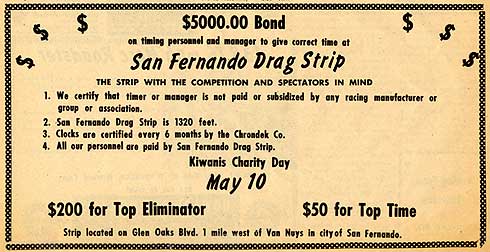|

Lifted from Drag News, May
2, 1959
As drag racing took off in the mid-Sixties, radio commercials
were added to the mix. A track’s part-time manager or
publicist usually wrote a 60-second commercial for a local
DJ to read. Some promoters, such as Bill Doner and the late
Steve Evans, avoided that expense by recording their own scripts.
With the Seventies came short television spots in major media
markets, typically relegated to late-night programming on
back channels. (E.g., “creature features” were
cheap buys, and attracted the targeted teenage demographic.)
Ticket prices did rise to cover these electronic-media campaigns,
but barely; as late as 1970, C.J. Hart was still charging
three bucks for Saturday nights at Lions.
Not until the appearance of
R.J. Reynolds Tobacco Company did our sport get serious about
marketing and sponsorships. Not coincidentally, regular TV
coverage arrived at the same time. Older readers will recall
that national-network coverage was unknown before 1963 —
and then only as a highlight segment of ABC’s Wide World
Of Sports. Television exposure stayed spotty until mid-1974,
when Winston came calling on IHRA, first, then NHRA.
The feds had just kicked cigarette advertising off the air.
Tobacco companies were looking for legal loopholes through
which they could send brand identification to viewers. They
found eager takers in NASCAR and drag racing (plus rodeo and
golf). Enter entire departments of salespeople and media managers
and handlers. While RJR has rightly been credited for dragging
drag racing into the corporate club, the main beneficiaries
seem to be team owners who fly their own jets and NHRA execs
who earn well into six figures. Hardcore fans haven’t
fared as well.
Even adjusted for inflation, a day at the races costs a whole
lot more than it did before — and buys but a fraction
of the entertainment value, in my opinion. (Didn’t we
pay five bucks to watch the entire inaugural PDA Meet in 1967?)
Winston’s money and promotional acumen served to supercharge
not only our sport’s transition into big business, but
also a redistribution of power to the marketing side. Thus
does the tail seem to be wagging the dog, three decades down
the road.
Look no further than Page Four of my National Dragster
(Nov. 25). Gary Darcy, the newly-promoted Senior Vice
President Of Sales And Marketing, had this to say to us 60,000-plus
members who remain: “With the recent addition of several
sales executives earlier this year, we believe it is important
that we integrate the sales and marketing departments in our
ongoing quest to secure new sponsors, service existing clients,
and foster an environment to encourage sponsor activation
with the intention of reaching a broader audience to grow
and build the sport of NHRA Drag Racing.”
In other words, what the sport really needs to capture lost
momentum and make new fans is more salespersons?
Lotsa luck, Mr. Darcy. 
 |
Now
and Then [11-8-05]
More Than A Ghost Town Sits
Frozen In The Badlands Of Bodie |
|
 |
|
|

